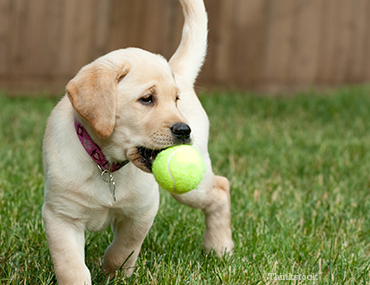
Dr. Phil Zeltzman is a traveling, board-certified surgeon in Allentown, PA. His website is www.DrPhilZeltzman.com. He is the co-author of “Walk a Hound, Lose a Pound” (www.WalkaHound.com).
AJ Debiasse, a technician in Stroudsburg, PA, contributed to this article.
Why did Montana need stomach surgery?
Montana, a 6 month old yellow lab, was the cutest dog ever. His owners could not resist when they saw his little black nose poking through the bars of the local shelter. They adopted him on the spot.
After a few weeks of puppy play, puppy cuddles and puppy kisses -- one morning, Montana's owners noticed that he wasn't acting quite right. He didn't run towards the kitchen door to go out. He was not interested in breakfast — which was unheard of, and the very small amount of water he drank immediately came back up. There was no doubt: Montana needed to go the vet.
The veterinarian performed blood work and belly X-rays. Blood work was normal, giving us no clues as to what was going on with Montana. The X-rays, however, told a different story. They showed several gas bubbles in the intestine and a metallic object shaped like a "D." Montana had something stuck in his intestine! The next step was surgery.
Montana was put under anesthesia, and his “exploratory” surgery began. The first abnormal finding was noted in the stomach. It contained firm material.
The vet made an incision in the stomach (a gastrotomy) to remove the material, which turned out to be a dozen pieces of thick leather, about a half inch wide.
After the stomach was stitched closed, investigation of the small intestine revealed a ring-shaped foreign body in Montana. Another incision was made in the intestine (an enterotomy) and a D-shaped metal object was removed. After stitching up the intestine and closely inspecting all other organs in the belly, the vet could not identify any other problem. Surgery was finished and Montana started to wake up.
 Our lab puppy was kept on IV fluids, pain medications and antibiotics. Of course, he had to wear a plastic cone (E. collar) around his neck. He began to eat and drink on his own the same evening and did very well overnight. No more vomiting occurred. The day after surgery, it was time for Montana to go back home.
Our lab puppy was kept on IV fluids, pain medications and antibiotics. Of course, he had to wear a plastic cone (E. collar) around his neck. He began to eat and drink on his own the same evening and did very well overnight. No more vomiting occurred. The day after surgery, it was time for Montana to go back home.
However, his recovery was not complete. Post surgical care included the following:
- Antibiotics and pain medications (for one week)
- The E. collar (for two weeks) until suture removal
- He was confined to a small area for one month
So what caused all these issues? Two days prior to his surgery Montana stole his collar from a counter top, and chewed on it while his owners were at work. The stomach contained multiple pieces of the leather collar, and the metallic D-shaped object was the ring to hook up the leash!
This was an avoidable surgery. Puppy-proofing a house is similar to child-proofing. Make sure anything your pet can reach (on all four paws or two) is put away. Any toys that can be ripped apart should only be played with under supervision.
A foreign object is only one of the many reasons your pet may exhibit vomiting, diarrhea, or lack of appetite. It is important not to procrastinate if your pet shows similar signs. If a foreign body is responsible, the longer it stays in, the higher the risk of irreparable damage.
Fortunately, Montana made a full recovery and lived happily ever after.
If you have any questions or concerns, you should always visit or call your veterinarian -- they are your best resource to ensure the health and well-being of your pets.
